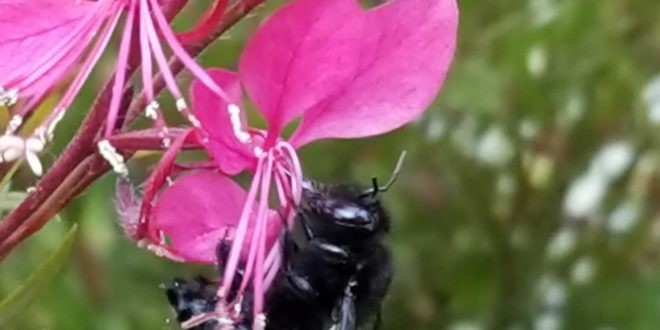August is always the easiest month in our Sunnyvale garden. While your attention is on lots of other things, the garden continues to grow.
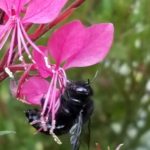 Our garden has dozens of plants that attract hummingbirds, butterflies, and bees. Here, a carpenter bee is enjoying a flower on one of the Butterfly bushes. Native to North America, gaura (Gaura lindheimeri) is a gorgeous, low-maintenance plant that thrives in hot, dry conditions. Gaura has tall graceful stems that are topped with masses of white or pink flowers that dance in the breeze, just like whirling butterflies. It starts flowering in early summer and continues right through autumn, when it’s time to cut the stems back to just above the ground.
Our garden has dozens of plants that attract hummingbirds, butterflies, and bees. Here, a carpenter bee is enjoying a flower on one of the Butterfly bushes. Native to North America, gaura (Gaura lindheimeri) is a gorgeous, low-maintenance plant that thrives in hot, dry conditions. Gaura has tall graceful stems that are topped with masses of white or pink flowers that dance in the breeze, just like whirling butterflies. It starts flowering in early summer and continues right through autumn, when it’s time to cut the stems back to just above the ground.
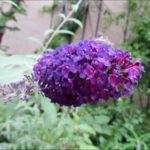 Buddleia davidii, aka Butterfly Bush (yes, this common name is given to several species under different genuses). The Butterfly Bush is a beautiful, fast-growing, deciduous shrub with masses of blossoms—long, seductively spiked trusses—that bloom from summer to autumn. Despite the “butterfly” name, keep in mind that this shrub is not a “host plant” for butterflies in that it does not support butterfly reproduction and life-cycle. Rather, it provides nectar to adult butterflies.
Buddleia davidii, aka Butterfly Bush (yes, this common name is given to several species under different genuses). The Butterfly Bush is a beautiful, fast-growing, deciduous shrub with masses of blossoms—long, seductively spiked trusses—that bloom from summer to autumn. Despite the “butterfly” name, keep in mind that this shrub is not a “host plant” for butterflies in that it does not support butterfly reproduction and life-cycle. Rather, it provides nectar to adult butterflies.
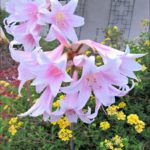 The Amaryllis Belladonna always bloom in August. Back in January, in our rainy season, the South African bulb produces large fleshy leaves. After a month or so, the leaves die off and you forget about the plant. Then, in mid-August, tall leafless stalks rise up and fragrant light-pink flowers open, thus giving them the common name of “Naked Ladies” or “Pink Ladies.” They naturalize readily in well-drained soil. Mulch over winter to extend cold hardiness. Cold hardy in zones 7-11. 24-36” tall.
The Amaryllis Belladonna always bloom in August. Back in January, in our rainy season, the South African bulb produces large fleshy leaves. After a month or so, the leaves die off and you forget about the plant. Then, in mid-August, tall leafless stalks rise up and fragrant light-pink flowers open, thus giving them the common name of “Naked Ladies” or “Pink Ladies.” They naturalize readily in well-drained soil. Mulch over winter to extend cold hardiness. Cold hardy in zones 7-11. 24-36” tall.
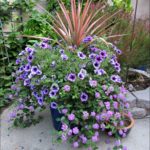 In October 2016, Marie and I visited the Albuquerque BioPark Botanic Garden. We enjoyed their collection of multi-tier pots aka Thriller-Filler-Spillers. The Thriller is the vertical component. The Spiller is the trailing component. The Filler fills the spaces between the Thriller and the Spiller. This past year I have tried several combinations and this pot is a big success. It has red-leaved Cordyline as the thriller; the filler and spiller are provided by petunias and lantana.
In October 2016, Marie and I visited the Albuquerque BioPark Botanic Garden. We enjoyed their collection of multi-tier pots aka Thriller-Filler-Spillers. The Thriller is the vertical component. The Spiller is the trailing component. The Filler fills the spaces between the Thriller and the Spiller. This past year I have tried several combinations and this pot is a big success. It has red-leaved Cordyline as the thriller; the filler and spiller are provided by petunias and lantana.
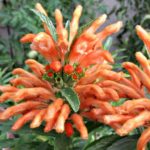
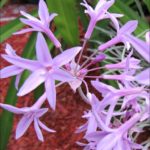 Another multi-tier pot: The Cheetos plant (aka Lion’s Tail; Leonotis leonurus) as the Thriller; Society Garlic and Globe Amaranth as Filler; and Bacopa as the Spiller. From late spring through fall appear the fuzzy orange curved tubular flowers held in whorls at spaced intervals around the top half of the long upright stems with newest buds produced near the branch tips. The Society Garlic provides reliable foliage throughout the year and delivers abundant 6-petaled blossoms starting in August.
Another multi-tier pot: The Cheetos plant (aka Lion’s Tail; Leonotis leonurus) as the Thriller; Society Garlic and Globe Amaranth as Filler; and Bacopa as the Spiller. From late spring through fall appear the fuzzy orange curved tubular flowers held in whorls at spaced intervals around the top half of the long upright stems with newest buds produced near the branch tips. The Society Garlic provides reliable foliage throughout the year and delivers abundant 6-petaled blossoms starting in August.
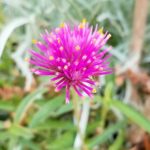 Yes, I showed the Globe Amaranth in July but it is still flowering in August. Globe amaranth plants are native to Central America. They grow from 6 to 12 inches high. They have fine white hairs covering young growth, which matures to thick green stems. The leaves are oval and arranged alternately along the stem. The blooms of globe amaranth start in June and may last until October. The flower heads are clusters of florets that resemble large clover flowers. They range in color from pink, yellow, white and lavender. The flowers dry well.
Yes, I showed the Globe Amaranth in July but it is still flowering in August. Globe amaranth plants are native to Central America. They grow from 6 to 12 inches high. They have fine white hairs covering young growth, which matures to thick green stems. The leaves are oval and arranged alternately along the stem. The blooms of globe amaranth start in June and may last until October. The flower heads are clusters of florets that resemble large clover flowers. They range in color from pink, yellow, white and lavender. The flowers dry well.
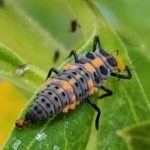 Our milkweed plant attracts a lot of aphids. An one day I spotted this fearsome looking predator, with SF Giant colors, chowing down the aphids. After some searching, this insect is …drum roll… a ladybug larva!
Our milkweed plant attracts a lot of aphids. An one day I spotted this fearsome looking predator, with SF Giant colors, chowing down the aphids. After some searching, this insect is …drum roll… a ladybug larva!
Although they look dangerous, lady beetle larvae are quite harmless to humans. After feeding on insect prey for several weeks, the larva pupates on a leaf. Adults tend to move on once pests get scarce, while the larvae remain and search for more prey.
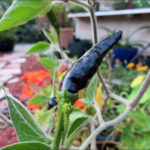 Another first for 2017. The black cobra pepper (a.k.a. goat’s weed pepper) has lots of peppers growing straight up from leaves covered in fine silvery hair. They have a biting bitter medium heat that reaches cayenne pepper levels of spiciness (Scovile 20,000 to 40,000; 3 to 16 times hotter than a Jalapeno). But like with other ornamental peppers, it lacks the fruity notes. it is best used like thai peppers: cooked whole in a dish to infuse the chile’s heat.
Another first for 2017. The black cobra pepper (a.k.a. goat’s weed pepper) has lots of peppers growing straight up from leaves covered in fine silvery hair. They have a biting bitter medium heat that reaches cayenne pepper levels of spiciness (Scovile 20,000 to 40,000; 3 to 16 times hotter than a Jalapeno). But like with other ornamental peppers, it lacks the fruity notes. it is best used like thai peppers: cooked whole in a dish to infuse the chile’s heat.
 Trachelium caeruleum, aka Blue Throatwort, aka Purple umbrella flower. Like a lavender-blue “Queen Anne’s Lace,” this Mediterranean perennial bears large, dense domes of intricate flowers dotted with tiny white “pins.” Lightly violet scented, the 3-4” clusters on upright stems look lovely in any garden and it good for cut flowers. Easy to grow & vigorous. Blooms mid-Summer till Fall, just in time for the butterflies. Deadhead & give good drainage. To 3’ x 2’ . In 2016 I planted some in the courtyard and the backyard and both have self-sown.
Trachelium caeruleum, aka Blue Throatwort, aka Purple umbrella flower. Like a lavender-blue “Queen Anne’s Lace,” this Mediterranean perennial bears large, dense domes of intricate flowers dotted with tiny white “pins.” Lightly violet scented, the 3-4” clusters on upright stems look lovely in any garden and it good for cut flowers. Easy to grow & vigorous. Blooms mid-Summer till Fall, just in time for the butterflies. Deadhead & give good drainage. To 3’ x 2’ . In 2016 I planted some in the courtyard and the backyard and both have self-sown.
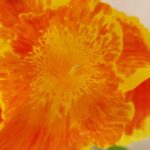
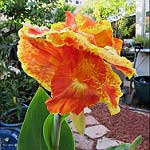 Last winter, I subdivided our Canna lily into 2 large tall pots. The one in the back yard is paired with Trailing Lotus flower. The one in the front yard is by itself. The stalks grew 4 feet tall. Each stalk produces about 8 to 12 flowers in succession. Because they are tropical plants, I position them with maximum southern exposure.
Last winter, I subdivided our Canna lily into 2 large tall pots. The one in the back yard is paired with Trailing Lotus flower. The one in the front yard is by itself. The stalks grew 4 feet tall. Each stalk produces about 8 to 12 flowers in succession. Because they are tropical plants, I position them with maximum southern exposure.
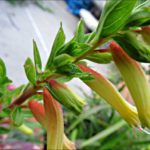 Another first for 2017. Cuphea micropetala (aka Candy Corn plant, aka Cigar plant) – A small evergreen shrub, native to mexico, that grows to 1-3 feet tall with narrow penstemon-like foliage that clothes the red stems. In late summer through late fall appear the tubular flowers which, when they first emerge, are yellow and age to orange from the base up, giving many of the flowers a two-toned appearance. The flowers have long exerted stamens and exude a slightly sticky substance that makes the inside of the flower glisten. A great plant for fall color as it displays the orange and reds associated with this harvest season. Attractive to bees.
Another first for 2017. Cuphea micropetala (aka Candy Corn plant, aka Cigar plant) – A small evergreen shrub, native to mexico, that grows to 1-3 feet tall with narrow penstemon-like foliage that clothes the red stems. In late summer through late fall appear the tubular flowers which, when they first emerge, are yellow and age to orange from the base up, giving many of the flowers a two-toned appearance. The flowers have long exerted stamens and exude a slightly sticky substance that makes the inside of the flower glisten. A great plant for fall color as it displays the orange and reds associated with this harvest season. Attractive to bees.
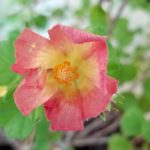 Emu Bush is a great addition to a drought-tolerant garden in Sunnyvale. Emu Bush Fuchsias (genus Eremophila) are Australian shrubby native plants and there are over two hundred varieties known. The name Eremophila means ‘desert lover’ and derives from the Greek eremos (desert) and phileo (to love).
Emu Bush is a great addition to a drought-tolerant garden in Sunnyvale. Emu Bush Fuchsias (genus Eremophila) are Australian shrubby native plants and there are over two hundred varieties known. The name Eremophila means ‘desert lover’ and derives from the Greek eremos (desert) and phileo (to love).
The fruits are eaten by emus, which disperse the seeds in their droppings. Note: Emus not included.
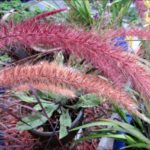 Another Thriller-Filler-Spiller pot. This one with Purple Fountain Grass as the Thriller. Purple fountain grass is a tender perennial. This ornamental grass cannot survive cold winters. The Filler and Spiller components should be spring and summer plants.
Another Thriller-Filler-Spiller pot. This one with Purple Fountain Grass as the Thriller. Purple fountain grass is a tender perennial. This ornamental grass cannot survive cold winters. The Filler and Spiller components should be spring and summer plants.
Growing purple fountain grass is easy. Although it can be planted nearly anytime, spring is the most suitable time for planting. These plants need to be placed in a sunny location with well-draining soil.
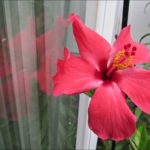 Hibiscus Reflection. We grow our Hibiscus in a medium-sized pot in our courtyard. Being a tropical plant, it really does not like the cold rainy season. But it loves August and September, the hotter the better. It is visited multiple times a day by our resident Anna hummingbird that gathers nectar from the base of the sepals — not the flowerhead.
Hibiscus Reflection. We grow our Hibiscus in a medium-sized pot in our courtyard. Being a tropical plant, it really does not like the cold rainy season. But it loves August and September, the hotter the better. It is visited multiple times a day by our resident Anna hummingbird that gathers nectar from the base of the sepals — not the flowerhead.
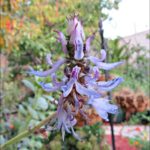 Plectranthus neochilus (Lobster Flower) – A perennial, aromatic, succulent herb, which grows as a ground-hugging wide spreading mat under 1 foot tall (a little taller in shade or when well watered) with rounded slightly scalloped gray-green foliage and deep blue and purple flowers that rise 3 to 6 inches above the foliage from spring through late fall. This year is our second growing this flower.
Plectranthus neochilus (Lobster Flower) – A perennial, aromatic, succulent herb, which grows as a ground-hugging wide spreading mat under 1 foot tall (a little taller in shade or when well watered) with rounded slightly scalloped gray-green foliage and deep blue and purple flowers that rise 3 to 6 inches above the foliage from spring through late fall. This year is our second growing this flower.
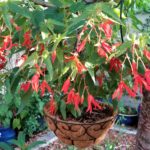
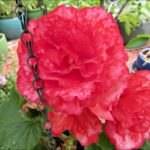 2017 was the first time I overwintered a tuberous begonia. The Santa Cruz Sunset (on the left) was doing great as a basket underneath the cherry tree until this weekend, when the stalks wilted under 108 degrees. The Red begonia (on the right) is still ok as of today.
2017 was the first time I overwintered a tuberous begonia. The Santa Cruz Sunset (on the left) was doing great as a basket underneath the cherry tree until this weekend, when the stalks wilted under 108 degrees. The Red begonia (on the right) is still ok as of today.
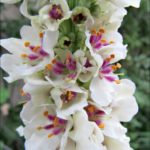 We first planted our Verbascum in October 2014. In June 2015, it bloomed again. Do not plant other things within 2 feet of it as it has large leaves. Erect stems bearing profuse saucer-shaped flowers that are usually yellow, but also white, brownish-red, or purple. Individual flowers are short lived but numerous, and flowering takes place over a long time. Most species self-sow, but not as a nuisance, and many seedlings vary slightly from the parent cultivar, thereby creating welcome surprises.
We first planted our Verbascum in October 2014. In June 2015, it bloomed again. Do not plant other things within 2 feet of it as it has large leaves. Erect stems bearing profuse saucer-shaped flowers that are usually yellow, but also white, brownish-red, or purple. Individual flowers are short lived but numerous, and flowering takes place over a long time. Most species self-sow, but not as a nuisance, and many seedlings vary slightly from the parent cultivar, thereby creating welcome surprises.
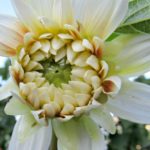 As an experiment, I replanted the hybrid Yellow Dinner-plate-dahlia bulbs from 2016. The flowers were smaller and the colors were less bright.
As an experiment, I replanted the hybrid Yellow Dinner-plate-dahlia bulbs from 2016. The flowers were smaller and the colors were less bright.
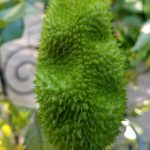 Invasion of the Body Snatchers. As I was searching for ripe tomatoes among the tomato plants, I discovered this large strange pod. It is the pod for Purple Trumpet Vine. Click on that link for a larger view. I have grown this vine for 15 years but have never noticed the pod.
Invasion of the Body Snatchers. As I was searching for ripe tomatoes among the tomato plants, I discovered this large strange pod. It is the pod for Purple Trumpet Vine. Click on that link for a larger view. I have grown this vine for 15 years but have never noticed the pod.
How could I miss this for 15 years? The logical reason is that the pod was hidden by the multiple tomato plants that were always planted in front of it. It is not like the pod swallowed me up and turned me into a alien. Be sensible. Stop looking at me like that.
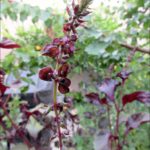 Perilla frutescens, or shiso, is an easy to grow herb in the mint family that is usually planted in the spring and harvested in the summer and fall. The red shiso is often described as having an anise flavor, whereas the green variety is said to be spicier and more like cinnamon. Leaves are often wrapped around sushi or served with “sashimi” as a garnish. They also are added to soups, tempura or dried and sprinkled over rice. Japanese chefs add red perilla to tofu or bean curd dishes or use it wrapped around pieces of meat. Leaves can also be boiled into a beverage similar to a mint julep.
Perilla frutescens, or shiso, is an easy to grow herb in the mint family that is usually planted in the spring and harvested in the summer and fall. The red shiso is often described as having an anise flavor, whereas the green variety is said to be spicier and more like cinnamon. Leaves are often wrapped around sushi or served with “sashimi” as a garnish. They also are added to soups, tempura or dried and sprinkled over rice. Japanese chefs add red perilla to tofu or bean curd dishes or use it wrapped around pieces of meat. Leaves can also be boiled into a beverage similar to a mint julep.
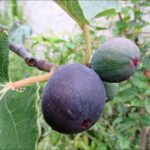
 Black Mission Figs. What climate change? The figs are ripe in August. In October 2016, after the fig harvest, I transplanted our 15-year-old fig tree into a 66 gallon pot. The spring (aka berba) harvest was low. This fall crop was average (last year was high). While this first crop since transplanting is average, I feel the fig tree has benefited from the extra room.
Black Mission Figs. What climate change? The figs are ripe in August. In October 2016, after the fig harvest, I transplanted our 15-year-old fig tree into a 66 gallon pot. The spring (aka berba) harvest was low. This fall crop was average (last year was high). While this first crop since transplanting is average, I feel the fig tree has benefited from the extra room.
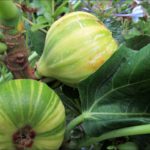
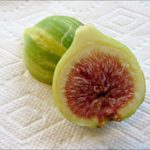 In 2016 my brother Adam brought me a Panache Fig tree from his home in southern California. The Panache Fig tree likes its new larger pot and southern exposure. The Panache’s small-to-medium-sized green fruits are beautifully patterned with yellow tiger stripes. Scrumptious fruits, with aromatic, highly flavorful blood-red flesh, make for fine fresh eating. Hardy, productive self-pollinating trees are especially well suited for regions with warmer climates and an extended growing season. ‘Panache Tiger Fig’ presents an extended harvest from early August to early November.
In 2016 my brother Adam brought me a Panache Fig tree from his home in southern California. The Panache Fig tree likes its new larger pot and southern exposure. The Panache’s small-to-medium-sized green fruits are beautifully patterned with yellow tiger stripes. Scrumptious fruits, with aromatic, highly flavorful blood-red flesh, make for fine fresh eating. Hardy, productive self-pollinating trees are especially well suited for regions with warmer climates and an extended growing season. ‘Panache Tiger Fig’ presents an extended harvest from early August to early November.
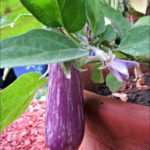 Fairy Tale eggplants are less seedy than their large Italian counterparts and lack their bitterness. If you are like me, you need a good recipe for these baby heirloom eggplants during the summer months. Throw these sweet little japanese eggplant on the grill alongside steak or lamb. With purple and white stripes and a miniature form, they are completely irresistible. Attractive, 2-4″ long by 3/4-1 1/4″ diameter, fruits are borne abundantly on compact 18-24″ plants. I am growing mine in a medium-size pot with red shiso and a chile plant.
Fairy Tale eggplants are less seedy than their large Italian counterparts and lack their bitterness. If you are like me, you need a good recipe for these baby heirloom eggplants during the summer months. Throw these sweet little japanese eggplant on the grill alongside steak or lamb. With purple and white stripes and a miniature form, they are completely irresistible. Attractive, 2-4″ long by 3/4-1 1/4″ diameter, fruits are borne abundantly on compact 18-24″ plants. I am growing mine in a medium-size pot with red shiso and a chile plant.
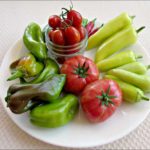 Tomatoes and Peppers. The mid-season Chile peppers are producing. I like the Padron peppers (on the left) as appetizers: Coat with olive oil and quickly roast in a cast-iron pan; sprinkle with salt. The Hungarian Hot Wax peppers are good any way: sliced in sandwiches; chopped into salsa; or stuffed with cream cheese; breaded; and then fried. The assortment of grape tomatoes, and other heirloom tomato like the Wine variety (in the middle)
Tomatoes and Peppers. The mid-season Chile peppers are producing. I like the Padron peppers (on the left) as appetizers: Coat with olive oil and quickly roast in a cast-iron pan; sprinkle with salt. The Hungarian Hot Wax peppers are good any way: sliced in sandwiches; chopped into salsa; or stuffed with cream cheese; breaded; and then fried. The assortment of grape tomatoes, and other heirloom tomato like the Wine variety (in the middle)
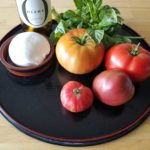
 This August we got to enjoy our bountiful harvest of tomatoes. One tasty dish with fresh tomatoes is sliced with fresh basil, mozzarella cheese, olive oil, and a splash of balsamic vinegar.
This August we got to enjoy our bountiful harvest of tomatoes. One tasty dish with fresh tomatoes is sliced with fresh basil, mozzarella cheese, olive oil, and a splash of balsamic vinegar.
Another great dish is Tomato tart or Tomato pie. Brush a pie shell with dijon mustard. Layer sliced tomatoes with cheese. I used Gruyere and Feta. Drizzle with olive oil with fresh herbs like basil, thyme, etc.
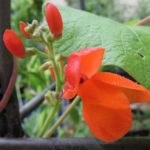
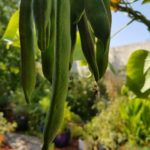 Normally, in our zone, beans should be planted in early spring. In May I planted Scarlet Runner Beans in the same pot as the Daphne bulbs. Grown by native Americans, these large, beautiful, vigorous vines grow over 10’. Flowers are very ornamental, in clusters of the brightest scarlet. Harvest is about 80 days. Good for snap, shell or dry beans. The huge seeds are very colorful, violet-purple mottled in black.
Normally, in our zone, beans should be planted in early spring. In May I planted Scarlet Runner Beans in the same pot as the Daphne bulbs. Grown by native Americans, these large, beautiful, vigorous vines grow over 10’. Flowers are very ornamental, in clusters of the brightest scarlet. Harvest is about 80 days. Good for snap, shell or dry beans. The huge seeds are very colorful, violet-purple mottled in black.
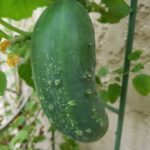
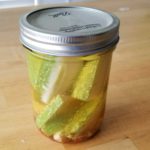 Cucumbers should really be grown in the ground where the vines can sprawl horizontally. I don’t have the real estate for that so I keep trying to grow them up trellises. This year I picked a variety that is good for pickling. I made quick dill pickles: Heat up your brine; pour over sliced cucumber; store in the refrigerator for up to 3 months.
Cucumbers should really be grown in the ground where the vines can sprawl horizontally. I don’t have the real estate for that so I keep trying to grow them up trellises. This year I picked a variety that is good for pickling. I made quick dill pickles: Heat up your brine; pour over sliced cucumber; store in the refrigerator for up to 3 months.
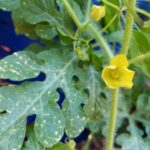
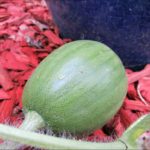 Like squash and cucumbers, watermelon should really be grown in the ground. I planted mine in the jumbo pot that holds the fig tree. it sprawled over the edge and is now running 6 feet in each direction. The “Moon and Stars” melon is a century-old heirloom from Tennessee/Missouri. large-fruited melon whose dark-green rind is speckled with tiny yellow dots (the stars) surrounding one or more larger yellow spots (the moon). It can get up to 25 pounds. As of Aug 31, it was 3 pounds.
Like squash and cucumbers, watermelon should really be grown in the ground. I planted mine in the jumbo pot that holds the fig tree. it sprawled over the edge and is now running 6 feet in each direction. The “Moon and Stars” melon is a century-old heirloom from Tennessee/Missouri. large-fruited melon whose dark-green rind is speckled with tiny yellow dots (the stars) surrounding one or more larger yellow spots (the moon). It can get up to 25 pounds. As of Aug 31, it was 3 pounds.
 Reflection in a bird bath. Our bird bath gets many visitors: birds, dragonflies, mud-wasps, squirrels.
Reflection in a bird bath. Our bird bath gets many visitors: birds, dragonflies, mud-wasps, squirrels.
 Marie captured this image of the Solar eclipse (this eclipse was partial in our region).
Marie captured this image of the Solar eclipse (this eclipse was partial in our region).
